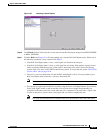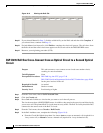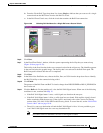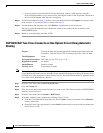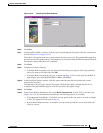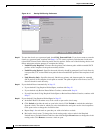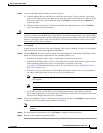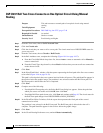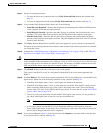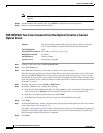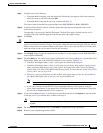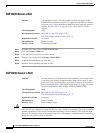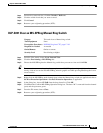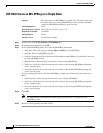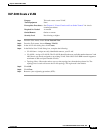
19-41
Cisco ONS 15454 SDH Procedure Guide, R7.2
October 2007
Chapter 19 DLPs D200 to D299
DLP- D237 Roll Two Cross-Connects on One Optical Circuit Using Manual Routing
Step 13 Set the circuit path protection:
• To route the circuit on a protected path, leave Fully Protected Path checked and continue with
Step 14.
• To create an unprotected circuit, uncheck Fully Protected Path and continue with Step 15.
Step 14 If you checked Fully Protected Path, choose one of the following:
• Nodal Diversity Required—Ensures that the primary and alternate paths within the SNCP portions
of the complete circuit path are nodally diverse.
• Nodal Diversity Desired—Specifies that node diversity is preferred, but if node diversity is not
possible, CTC creates fiber-diverse paths for the SNCP portion of the complete circuit path.
• Link Diversity Only—Specifies that only fiber-diverse primary and alternate paths for SNCP
portions of the complete circuit path are needed. The paths might be node-diverse, but CTC does not
check for node diversity.
Step 15 Click Next. Beneath Route Review and Edit, node icons appear for you to route the circuit manually.
The green arrows pointing from the source node to other network nodes indicate spans that are available
for routing the circuit.
Step 16 Complete the “DLP-D98 Provision a High-Order Circuit Route” task on page 17-96, or the “DLP-D3
Provision a Low-Order VC12 Circuit Route” task on page 17-2.
Caution The following is only seen with DUAL roll mode when both ends of the circuit use the card(s) mentioned
in this statement. If the termination card is a DS3i-N-12, E1-N-14, E1-42 or E3-12 card, a roll will occur
even if a valid signal is not detected on the Roll To port. The absence of a PDI-P downstream for LOS,
LOF, and AIS line defects causes the roll to continue without a valid signal.
Step 17 Click Finish. In the Circuits tab, verify that a new circuit appears.
This circuit is the Roll To circuit. It is designated with the Roll From circuit name appended with
ROLL**.
Step 18 Click the Rolls tab. Two new rolls now appear on the Rolls tab. For each pending roll, view the Roll Valid
Signal status. When one of the following conditions is met, continue with Step 19.
• If the Roll Valid Signal status is true, a valid signal was found on the new port.
• If the Roll Valid Signal status is false, a valid signal was not found. Wait until the signal is found
before continuing with the next step. If the signal is not found, refer to the Circuits and Timing
section of the Cisco ONS 15454 SDH Troubleshooting Guide. To cancel the roll, see the “DLP-D240
Cancel a Roll” task on page 19-44.
• The roll is a one-way destination roll and the Roll Valid signal status is false. It is not possible to
get a Roll Valid Signal status of true for a one-way destination roll.
Note You cannot cancel an automatic roll after a valid signal is found.
• A roll can be forced onto the Roll To Circuit destination without a valid signal by using the
Force Valid Signal button. If you choose Force Valid Signal, traffic on the circuit that is involved in
the roll will be dropped when the roll is completed.
Step 19 If you selected Manual in Step 5, click each roll and click Complete to route the traffic to the new port.
If you selected Auto, continue with Step 20.



